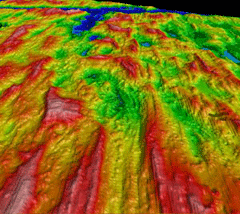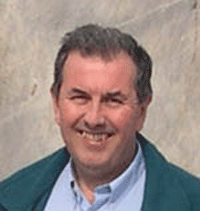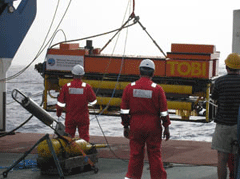Earth's Crust Section Gone
Air Date: Week of March 30, 2007

An 'aerial' view of part of the study area. This is on the Mid-Atlantic Ridge at 14ºSA, looking south. (Courtesy of The Classroom@Sea Project)
Researchers aboard the RRS James Cook have set out to determine exactly why a section of the earth's crust is missing along the Mid-Atlantic Ridge. Geophysicist and mission leader Roger Searle of Durham University speaks to host Bruce Gellerman from his ship cabin.
Transcript
GELLERMAN: If Sherlock Holmes was on the trail he might call it:
“The Case of the Missing Crust” It seems scientists can’t find a giant piece of the earth's crust. It’s supposed be in the ocean part of the Mid-Atlantic ridge several thousand square kilometers down, but it’s missing.
[MUSIC: The Crazy World of Arthur Brown “Fire!” from ‘Fire! The Story of Arthur Brown’ (Castle Recordings - 2003)]
Scientific sleuths from Britain’s National Oceanography Research Center have set sail with special sonar and deep-sea drilling equipment in search of clues to solve the mystery. Joining us from his cabin aboard the R-R-S James Cook is mission-leader and geophysicist Roger Searle, of Durham University.
Professor Searle, good to speak to you.
SEARLE: Yes. Good to speak to you to.
GELLERMAN: Where are you right now?
SEARLE: Halfway between the island of Tenerife and the island of Barbados.

"Image of the Mid-Atlantic Ridge. You can see how the ridge is broken up into segments by fractures running roughly perpendicular to the ridge axis. The red dot shows the area where the team on board the ship will be working." (Courtesy of The Classroom@Sea Project/GEBCO)
SEARLE: Well, I should probably explain what we mean by that. Normally we think that the oceanic crust is made up of about seven or eight kilometers thickness of volcanic rocks, which are essentially the results of magma cooling down and solidifying. Now, over the past ten or fifteen years, a succession of researchers in this region have found that when they sampled the sea floor they were not finding many of these kinds of volcanic rocks that they expected. But what they were finding instead was rocks which are typical of the Earth’s mantle. So it looks as though for some reason that volcanic crust is not here. That’s one of the things we’re trying to confirm at the moment.
GELLERMAN: Are there other areas in the world’s oceans where it’s missing?
SEARLE: Um, there probably are. I think that when we first wrote the proposal to do this study this was certainly the best known of such areas at the time. And since then we’ve discovered there are other areas. Some are in the southwest Indian Ocean and in particular very extensive areas of missing crust, if you like, have been found in the Arctic.

Professor Roger Searle (Courtesy of The Classroom@Sea Project)
SEARLE: Well the outer part, what makes up the tectonic plates or what we technically call the lithosphere, this is a very strong rigid shell, which floats right at the surface of the Earth. And then below that is the mantle and the mantle is not quite as strong so although it’s mostly a solid it can move very very slowly like ice moving in a glacier or something like that. Now, the lithosphere, the solid plates at the top is made of both of the very upper most part of the mantle and this thin layer on top which is the crust. And the difference between them is that the crust is chemically distinct.
GELLERMAN: So where did the crusts go?
SEARLE: Well, I mean there are two options. Either it was formed and it went somewhere else or maybe there are three options. One is it never formed at all, or one is that there was some melting taking place, which would normally lead to formation of the crust. That melt never actually got up to the sea floor so we don’t see it.
GELLERMAN: Does this help us in any way with other parts of our understanding or applied understandings of geology in the Earth’s crust?

TOBI (Towed Ocean Bottom Instrument - right) is used to build up images of the seafloor surface so that suitable drilling sites can be selected.(Courtesy of The Classroom@Sea Project)
GELLERMAN: Is a missing piece of the Earth’s crust a problem?
SEARLE: I don’t think it’s a problem. No, it’s still solid sea floor at the bottom at the bottom of the ocean. The water’s not going to drain away. It’s a problem for scientists just to understand how that happens.
GELLERMAN: It’s not like pulling the plug in a bathtub.
SEARLE: It’s not like pulling the plug at all, no.
GELLERMAN: Well Professor Searle thank you very much. Appreciate it.
SEARLE: Ok, thank you. Cheerio
Links
Living on Earth wants to hear from you!
Living on Earth
62 Calef Highway, Suite 212
Lee, NH 03861
Telephone: 617-287-4121
E-mail: comments@loe.org
Newsletter [Click here]
Donate to Living on Earth!
Living on Earth is an independent media program and relies entirely on contributions from listeners and institutions supporting public service. Please donate now to preserve an independent environmental voice.
Newsletter
Living on Earth offers a weekly delivery of the show's rundown to your mailbox. Sign up for our newsletter today!
 Sailors For The Sea: Be the change you want to sea.
Sailors For The Sea: Be the change you want to sea.
 The Grantham Foundation for the Protection of the Environment: Committed to protecting and improving the health of the global environment.
The Grantham Foundation for the Protection of the Environment: Committed to protecting and improving the health of the global environment.
 Contribute to Living on Earth and receive, as our gift to you, an archival print of one of Mark Seth Lender's extraordinary wildlife photographs. Follow the link to see Mark's current collection of photographs.
Contribute to Living on Earth and receive, as our gift to you, an archival print of one of Mark Seth Lender's extraordinary wildlife photographs. Follow the link to see Mark's current collection of photographs.
 Buy a signed copy of Mark Seth Lender's book Smeagull the Seagull & support Living on Earth
Buy a signed copy of Mark Seth Lender's book Smeagull the Seagull & support Living on Earth

